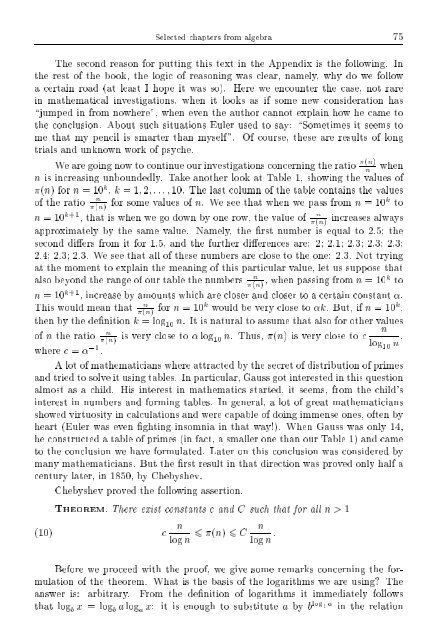SELECTED CHAPTERS FROM ALGEBRA I. R. Shafarevich Preface
SELECTED CHAPTERS FROM ALGEBRA I. R. Shafarevich Preface
SELECTED CHAPTERS FROM ALGEBRA I. R. Shafarevich Preface
You also want an ePaper? Increase the reach of your titles
YUMPU automatically turns print PDFs into web optimized ePapers that Google loves.
Selected chapters from algebra 75The second reason for putting this text in the Appendix is the following. Inthe rest of the book, the logic of reasoning was clear, namely, why do we followa certain road (at least I hope it was so). Here we encounter the case, not rarein mathematical investigations, when it looks as if some new consideration has\jumped in from nowhere", when even the author cannot explain how hecametothe conclusion. About such situations Euler used to say: \Sometimes it seems tome that my pencil is smarter than myself". Of course, these are results of longtrials and unknown work of psyche.We are going now to continue our investigations concerning the ratio (n)nwhenn is increasing unboundedly. Take another look at Table 1, showing the values of(n) for n =10 k , k =1 2 ... 10. The last column of the table contains the valuesof the ration for some values of n. We see that when we pass from n (n) =10k ton =10 k+1 n,thatiswhenwegodown by one row, the value of increases always(n)approximately by the same value. Namely, the rst number is equal to 2.5 thesecond diers from it for 1.5, and the further dierences are: 2 2.1 2.3 2.3 2.32.4 2.3 2.3. We see that all of these numbers are close to the one: 2.3. Not tryingat the moment to explain the meaning of this particular value, let us suppose thatnalso beyond the range of our table the numbers , when passing from n (n) =10k ton =10 k+1 , increase by amounts which are closer and closer to a certain constant .nThis would mean that for n (n) =10k would be very close to k. But, if n =10 k ,then by the denition k =log 10 n. It is natural to assume that also for other valuesof n the ration is very close to log n(n)10 n. Thus, (n) isvery close to clog 10 n ,where c = ;1 .A lot of mathematicians where attracted by the secret of distribution of primesand tried to solve it using tables. In particular, Gauss got interested in this questionalmost as a child. His interest in mathematics started, it seems, from the child'sinterest in numbers and forming tables. In general, a lot of great mathematiciansshowed virtuosity in calculations and were capable of doing immense ones, often byheart (Euler was even ghting insomnia in that way!). When Gauss was only 14,he constructed a table of primes (in fact, a smaller one than our Table 1) and cameto the conclusion we have formulated. Later on this conclusion was considered bymany mathematicians. But the rst result in that direction was proved only half acentury later, in 1850, by Chebyshev.Chebyshev proved the following assertion.THEOREM. There exist constants c and C such that for all n>1(10) cnlog n 6 (n) 6 Cnlog n :Before we proceed with the proof, we give some remarks concerning the formulationof the theorem. What is the basis of the logarithms we are using? Theanswer is: arbitrary. From the denition of logarithms it immediately followsthat log b x = log b a log a x: it is enough to substitute a by b log b a in the relation
















